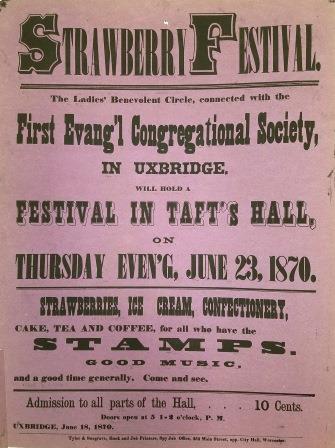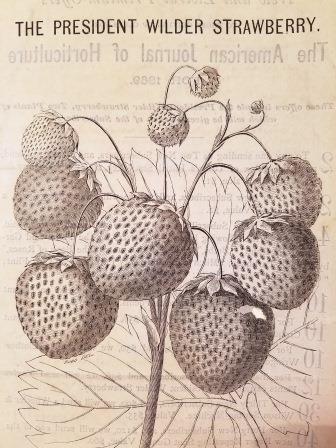By Rakashi Chand, Reader Services
In New England, the arrival of summer is synonymous with strawberries. Strawberry plants (fields) can be found throughout the region, and the strawberry harvest in late May and early June goes hand-in-hand with the most beautiful part of the year. The lovely, fragrant evenings and the final sigh of relief as New Englanders pack their coats away for the summer inevitably lead to the sudden desire to celebrate the arrival of the long-awaited warm months of summer. So, naturally, spring fetes were often “Strawberry Festivals.” The delicious berry was a welcome addition to the kitchen after months of cooking and consuming dried fruit. Every dish on the table was augmented, filled, or garnished with the beautiful, vibrant, and sweet berry.
In the nineteenth century Strawberry Festivals or parties were very popular. The strawberry was the first crop of the summer, and the region was dotted with strawberry farms. Strawberry festivals were popular events celebrated in many New England towns. Here at the Historical Society we have a few examples of broadside advertisements for local strawberry festivals from the late nineteenth century.

Harvard’s Hasty Pudding Club (yes, they were up to the same silliness all those years ago!) produced an annual show called “Strawberry Night” in June.

But for us at the Massachusetts Historical Society, such festivals have a very special significance as our annual strawberry festival may have indeed led to the bequest of our biggest benefactor. According to Robert C. Winthrop, MHS President from 1855-1885, it was the invitation to the Massachusetts Historical Society’s Strawberry Festival that led Thomas Dowse to donate his prized library to the MHS, and to that end, Winthrop says, “the regeneration of our Society may thus be fairly dated.”
“SPECIAL MEETING, JUNE, 1886. A Social Meeting of the Society was held at the house of Mr. Charles Deane, in Cambridge, on Friday, the 18th instant, at five o’clock, P.M.
The Hon. Robert C. Winthrop then spoke as follows :
“Passing from this topic, let me say how glad I am to find myself at another social meeting of our old society at Cambridge…
…But another of these Cambridge meetings was still more memorable, and can never be forgotten in the history of our Society. I refer, as I need hardly say, to the meeting at good George Livermore’s in 1856, just thirty years ago. From that meeting came the library and large endowment of our great benefactor, Thomas Dowse. Mr. Dowse was a neighbor and friend of Mr. Livermore, and had been specially invited by him to come over to our strawberry festival. Age and infirmities prevented his acceptance of the invitation; but the occasion induced him to inquire into the composition and character of our Society, and he forthwith resolved to place his precious books, the costly collections of a long life, under our guardianship, and to make them our property forever. From that meeting the regeneration of our Society may thus be fairly dated. Cambridge strawberries have ever since had a peculiar flavor for us, – not Hovey’s Seedling, though that too was a Cambridge product, but what I might almost call the Livermore Seedling or the Dowse Graft, which were the immediate fruits of our social meeting at Mr. Livermore’s.”*
Read more about Thomas Dowse and the Dowse Library here! (http://www.masshist.org/database/210)

Ten years ago, The Librarian of the Massachusetts Historical Society, Peter Drummey, suggested the library staff resurrect the age-old tradition; one hundred and fifty years later, a Strawberry Festival was once again held by the Massachusetts Historical Society.
The Library Staff of the Massachusetts Historical Society holds a Strawberry Festival every year in late May or early June for the staff, friends, volunteers, researchers and patrons of the Massachusetts Historical Society. We will be hosting our 2017 Strawberry Festival on Friday, June 2nd.
*Proceedings of the Massachusetts Historical Society, Second Series, Vol. 3, [Vol. 23 of continuous numbering] (1886 – 1887), pp. 53-54

